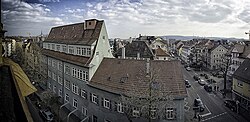Bad Cannstatt
Stuttgart-Bad Cannstatt | |
|---|---|
 | |
| Country | Germany |
| State | Baden-Württemberg |
| Admin. region | Stuttgart |
| District | Stuttgart |
| City | Stuttgart |
| Subdivisions | 19 Boroughs |
| Government | |
| • Direktor | Bernd-Marcel Loeffler (SPD) |
| Area | |
| • Stadtbezirk of Stuttgart | 15.713 km2 (6.067 sq mi) |
| Elevation | 205 m (673 ft) |
| Population (2014) | |
| • Metro | 69,543 |
| Time zone | UTC+01:00 (CET) |
| • Summer (DST) | UTC+02:00 (CEST) |
| Postal codes | 70331-70378 |
| Dialling codes | 0711 |
| Vehicle registration | S |
| Website | www |
Bad Cannstatt, formerly just "Cannstatt" or "Kannstadt" (until 1900), is one of the outer stadtbezirke, or city districts, of Stuttgart in Baden-Württemberg, Germany. Bad Cannstatt is the oldest and most populous of Stuttgart's districts, and one of the most historically significant towns in the area of Stuttgart.[Note 1] The town is home to the Cannstatter Wasen and Cannstatter Volksfest beer festivals, the Mercedes-Benz Arena (VfB Stuttgart), the Hanns-Martin-Schleyer-Halle, and the Porsche-Arena.
Etymology
In the past, Bad Cannstatt has been known as simply Cannstatt or Kannstatt,[2] Cannstadt, Canstatt, Kanstatt, and Condistat.[3] Its name was changed to mention the town's spas on 23 July 1933. Cannstatt's name originates from a Castra stativa, Cannstatt Castrum, the massive Roman Castra that was erected on the hilly ridge in 90 AD to protect the valuable river crossing and local trade.[4][5]
History
Bad Cannstatt lies on the Neckar at the convergence of various regional trails.[3] It was founded during the Roman period, although the area was inhabited by the Seelberg mammoth hunters during the last glacial period.[citation needed] The nearby Sielberg is notable for its caverns and fossils.[3]
Records survive of Roman knowledge of the area's springs.[2] The present name first appeared as the seat of a court held by Charlemagne in the 8th century while trying the rebellious dukes of Alemannia and Bavaria. Cannstatt was the capital of the county of Württemberg into the 14th[2] or 15th century;[3] the Rotenberg was the location of the ruling house's ancestral castle.[2] Cannstatt subsequently formed part of the duchy, electorate, and kingdom of Württemberg. It lay about 2.5 miles (4 km) from Stuttgart proper,[3] although it has since grown to include Bad Cannstatt. In the 13th or 14th century, Louis the Bavarian expanded its rights and privileges to equality with Esslingen. Its 15th-century cathedral was dedicated to St Uffo.[3] In 1755, the Great Lisbon Earthquake caused the town hall to subside about 3 feet (1 m).[6] Amid the Napoleonic Wars, the town was the site of a French victory over the Austrians on 21 July 1796.[2]
In the 19th century, it boasted an attractive town hall, a royal theater, a market house, the Wilhelma and Rosenstein palaces, and extensive industry including wool-spinning, dyeing, steelmaking, and construction of machinery. There were then about 40 mineral springs, which were considered beneficial for "dyspepsia and weakness of the nervous system",[3] as well as "diseases of the throat".[2] Cannstatt was the site of Gottlieb Daimler's invention of the motorcycle[citation needed] and housed an automobile factory before the First World War. Around that time, it also had notable railway and chemical works and a brewery. It was incorporated into Stuttgart in 1904.[2]
Of the 19 surviving mineral springs, 11 are recognized as state wells.[clarification needed] In the world, it is now second to only Újbuda in Budapest, Hungary, in scale.[7] The Mombach spring is the only one that releases its water without pressure in large quantities; its outflow is used in the adjacent baths and the Wilhelma spa.[citation needed]
Famous Residents
Famous people associated with Bad-Cannstatt include:
- Gottlieb Daimler, inventor of the motorcycle and part-founder of Daimler-Benz.
References
Citations
- ^ "The History of Stuttgart". worldtravelguide.net. World Travel Guide.
- ^ a b c d e f g EB (1911).
- ^ a b c d e f g EB (1878), p. 26.
- ^ "Stuttgart (Germany)". Encyclopædia Britannica. 2009.
- ^ "Early history of Stuttgart". en.driveline-online.de. driveLINE.
- ^ EB (1878), p. 27.
- ^ "Wissenswertes", Stuttgart Rallye.
Notes
Bibliography
- , Encyclopædia Britannica, 9th ed., Vol. V, New York: Charles Scribner's Sons, 1878, pp. 26–27.
- , Encyclopædia Britannica, 11th ed., Vol. V, Cambridge: Cambridge University Press, 1911, p. 189.



